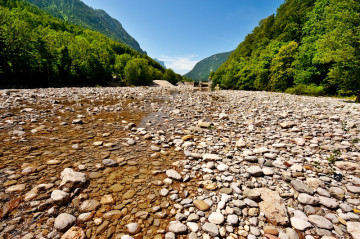Congratulations on successfully completing another year of disclosure! Utilizing CDP's platform for disclosure empowers you and your organization to embark on ambitious corporate action. This practice helps monitor global advancement towards an economy that serves the well-being of both people and the planet.
In 2022, CDP had 23,592 companies disclose through the climate change, forests, and water security questionnaires. However, only 3,908 (17%) companies submitted a water security questionnaire. Whether business operations are located within a watershed that has sufficient supply to meet demand or not, it is integral for companies to submit the Water Security questionnaire. Water is a shared resource that impacts companies, big and small, and the communities in which they operate. Without water, it is essentially impossible to continue business operations.
Below are five key areas to think about to improve your score or begin responding to the CDP Water Security questionnaire:
Establishing a Baseline
A critical step in submitting your water security questionnaire is to establish a baseline. By identifying and quantifying your current water withdrawal, consumption, discharge, water sources, and associated risks, you lay the foundation for accurate reporting and meaningful progress assessment. This baseline not only aids in responding effectively to CDP's Water Security questionnaire but also provides a starting point against which future improvements can be measured. It's a proactive approach that not only enhances your company's understanding of its water-related impacts but also positions you to contribute meaningfully to global sustainability efforts.
Water Risk Assessments
After collecting data on your water usage, a recommended next step would be to perform a Water Risk Assessment (WRA). Just as companies completing the Climate CDP questionnaire perform Climate Assessments, those tackling the Water CDP questionnaire should consider conducting either a water risk screening or a more comprehensive and detailed WRA. A WRA can be used for multiple purposes and can provide insights that help identify and manage water risks and associated mitigation measures. The WRA generally has three main goals:
- To identify potential key risks to protect operations in the short to medium term.
- To help inform business objectives and decisions in the medium to long term, such as acquisitions or expansions.
- To begin water stewardship strategy development.
An effective WRA can significantly improve your Water CDP score by bolstering the comprehensiveness and accuracy of your responses. By addressing and mitigating identified risks, you not only enhance your company's overall performance but also demonstrate your commitment to sustainable water management. This, in turn, positively influences how your company is perceived by stakeholders, including investors, customers, and regulatory bodies.
Additional Resources: Download our full Water Risk Assessment Methodology
Developing A Corporate Water Strategy
Integrating the water risk assessment findings into your water resource management strategy not only aligns with the essence of responsible corporate stewardship but also serves as a catalyst for elevating your Water CDP score. As you navigate the complexities of water usage and its associated challenges, harnessing the insights gleaned from a WRA empowers you to make informed decisions, promote sustainable practices, and ultimately contribute to a more water-secure and resilient future.
Crafting a strategic engagement plan that seamlessly incorporates water management into your overarching company strategy is a crucial step. This strategic integration is essential for making water considerations an integral part of your business's core objectives and operations, signaling a commitment to sustainable practices that resonate with stakeholders.
Implementing this strategy involves translating your goals into actionable practices. Internally set water reduction targets and re-use initiatives can serve as practical benchmarks, fostering a culture of accountability and contributing to water conservation efforts. Additionally, focusing on operational water efficiency is pivotal. By scrutinizing water usage across various functions and embracing efficient technologies, you not only exemplify responsible resource management but also potentially achieve substantial cost savings.
Expand Data Collection and Monitoring to the Supply Chain
Expanding data collection, water monitoring, and water risk screening to the supply chain also represents a vital progression in the journey toward comprehensive water management. As the interconnectedness of global commerce becomes increasingly evident, understanding the water footprint of your supply chain is paramount.
By extending data collection and monitoring practices to encompass suppliers and partners, you gain insights into the holistic impact of your operations. This transparency enables the identification of potential risks and inefficiencies, improving business resiliency, and fostering collaboration with stakeholders to implement sustainable practices throughout the supply chain.
Furthermore, such an approach not only strengthens resilience but also showcases your commitment to responsible water stewardship, positioning your organization as a leader in sustainable business practices.
Looking Forward
Evaluating the CDP Water Security questions in the questionnaire that are not presently scored is a strategic move that forward-thinking companies should consider. While these questions might not contribute to your current Water CDP score, they offer valuable insights into emerging trends and priorities within the realm of water management. Engaging with these questions prompts companies to proactively address water conservation, risk management, and sustainable practices that may weigh more heavily in the future.
By taking these questions into account and preparing for their potential inclusion in scoring mechanisms, you can position your organization to be at the forefront of evolving sustainability benchmarks. This approach demonstrates adaptability, foresight, and a commitment to staying ahead of industry trends, ensuring that your company remains poised for success in the ever-evolving landscape of water management and reporting.
Wrap-Up
In conclusion, as we celebrate another successful year of disclosure, it's evident that utilizing CDP's platform for disclosure is a powerful tool for fostering corporate responsibility and sustainable action. The importance of water security cannot be understated, as it is a shared resource critical to business operations and community well-being.
By embracing the above strategies, your organization not only enhances its understanding of water-related impacts but also positions itself to make meaningful contributions to global sustainability efforts. Proactive engagement with emerging trends and priorities ensures that your company remains a leader in the ever-evolving landscape of water management and reporting, demonstrating adaptability, foresight, and a commitment to a more water-secure and resilient future.
Need more help? Reach out to our Water Stewardship team for guidance on your Corporate Water Strategy today!
Want more news and insights like this?
Sign up for our monthly e-newsletter, The New Leaf. Our goal is to keep you updated, educated, and even a bit entertained as it relates to all things EHS and sustainability.
Have any questions?
Contact us to discuss your environment, health, safety, and sustainability needs today.







